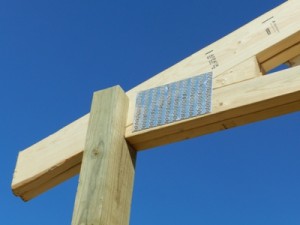A Truss Story…
I began my career in the prefabricated metal plate connected wood truss industry back in 1977 at what was then Spokane Truss, now it is a ProBuild truss plant. From there my next stop was their sister plant Coeur d’Alene Truss (now Coeur d’Alene Builders Supply).
 In my two plus years with them, in many different capacities, we never nailed multiple ply trusses together – we did not even have a nail gun at either facility! We couldn’t have nailed trusses together if we wanted to.
In my two plus years with them, in many different capacities, we never nailed multiple ply trusses together – we did not even have a nail gun at either facility! We couldn’t have nailed trusses together if we wanted to.
When the housing market down turned in August 1979, I began my search for better opportunities. At my first stop I found out why truss manufacturers don’t nail trusses together…..
The now defunct Tilton Truss in Woodinville, Washington was my first “port of call” in my search. As I was given the tour of their plant, I saw some truss manufacturing equipment I was unfamiliar with – the steel connector plates were being air nailed into place by the truss builders, and then pushed out of the building and through a roller press. I looked up at the ceiling. The ceiling was covered with literally thousands upon thousands of nails….I now knew what truss builders were doing with their spare time!
I ended up spending 23 years in the truss industry, most of those in an ownership position.
There are many reasons for a truss company to not be nailing trusses together – besides the obvious safety issues.
Most truss manufacturers are set up so the trusses travel through a set of “finish rollers” placed in the wall to do the final seating of the pressed in plates. Once the individual trusses are outside of the building, mechanical stackers tip each truss up onto either bunks or finished truss carts. In order to nail two trusses together, they would need to be individually manhandled onto a location which was clean, flat and has no traffic – nailed together, and then placed in yet another location for storage until shipping. Hugely labor intensive.
Truss builders are not carpenters. They are trained to build trusses. The expectation of them being able to perfectly align two trusses each and every time – and properly nail them together is fraught with the possibility of failure. They just don’t have the set-up, equipment and time to do it exactly right every single time.
The truss company needs to turn a profit to stay in business. They make money by building trusses. Fifteen years ago I figured the average truss builder would build at least $1000 of trusses every day. Somewhere between 50 and 60% of a truss cost is materials, the balance is labor and profit. In today’s world, a truss manufacturing operation manager would need to charge out at least $120 per person hour to nail those trusses together.
In the plant, if damage is to happen to a truss, it almost universally comes from handling with a forklift or forklifts. Trusses nailed together – one of them gets damaged and needs to be repaired, now we are talking some work as the trusses need to be pulled apart and all of the nails removed!
On the jobsite – it is far easier to maneuver trusses together as individual units, those two ply trusses would prove to be backbreakers.
When the joist hangers for the roof purlins are installed, the flange towards the double truss should be attached with 10d common nails. These three inch long nails will aptly connect the two trusses together at the location of every roof purlin, in most cases taking care of around one-half (if not more) of the required top chord nails.
In the end, we want to deliver the ultimate post frame (pole) building experience. For those who desire the trusses to be nailed together, in the plant, we will happily ask (upon your request) if it is something they will do and if so, what the charge would be. This allows each individual client to determine the most efficient and cost effect situation for their own individual project.






